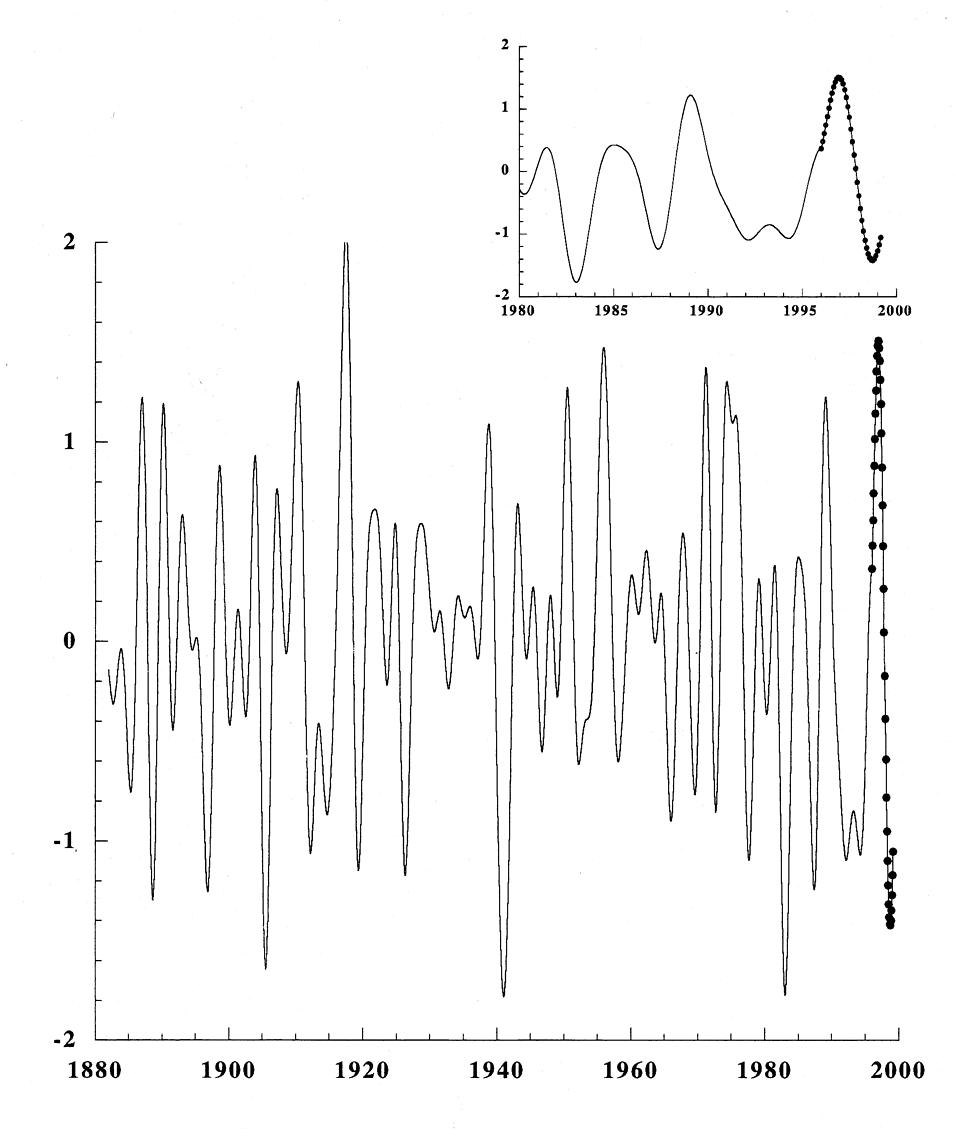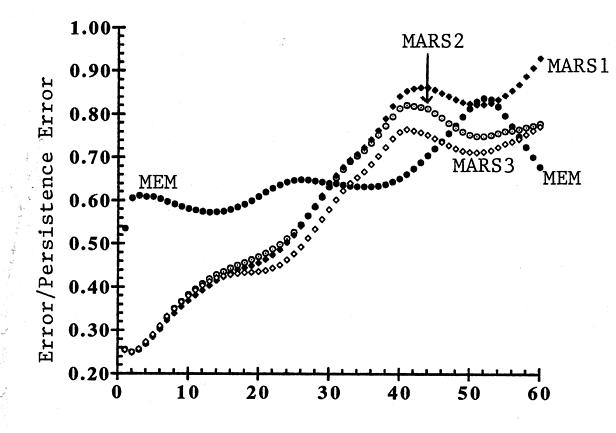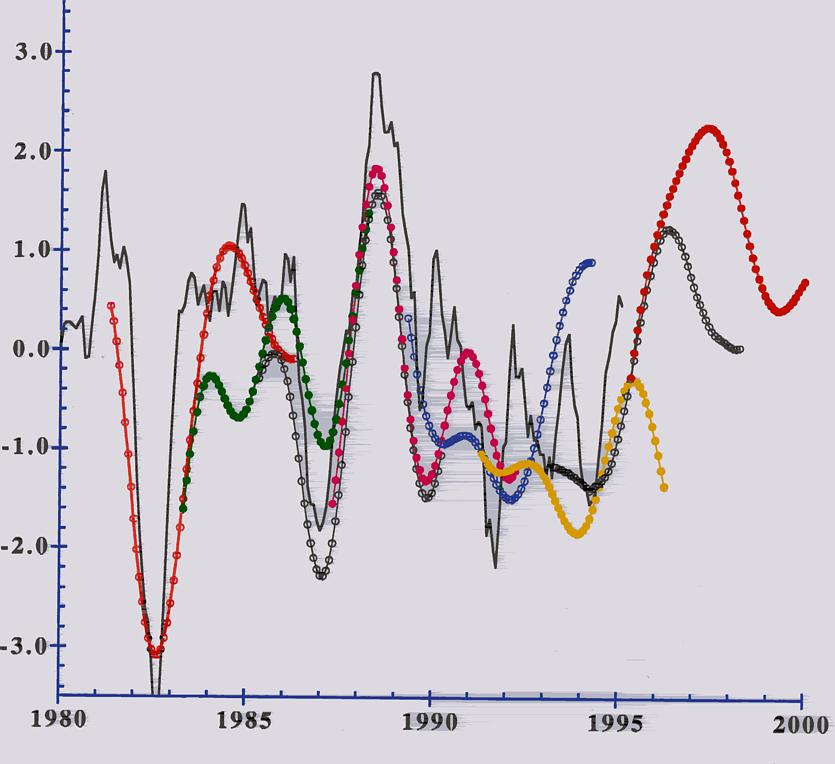[Next Article] -
[Previous Article]
Complex Singular Spectrum Analysis and Multivariate
Adaptive Regression Splines Applied to Forecasting the Southern
Oscillation
Christian Keppenne1 and Upmanu Lall2
1clk@jpl.nasa.gov http://yabloko.jpl.nasa.gov/clk.html
2ulall@kernel.uwrl.usu.edu http://grumpy.usu.edu/~FALALL/ulall.html
1Jet Propulsion Laboratory, Pasadena, California 91109
2Utah Water Research Laboratory, Utah State University, Logan, Utah 84322
A few years ago, Keppenne and Ghil (1992a,b;
see also previous issues of this Bulletin) introduced a
methodology to forecast the Southern Oscillation Index
(SOI) by applying the maximum entropy method
(MEM) to produce autoregressive forecasts of a set of
adaptively filtered time series resulting from the
application of singular spectrum analysis (SSA) to the
raw monthly mean SOI. The success of this
methodology has led to the development of a
multivariate prediction scheme based on the same
concepts, but with the substitution of multivariate SSA
for univariate SSA (Keppenne and Ghil 1993, Jiang et
al. 1995). The technique described herein introduces
the following improvements to the linear prediction
scheme used to issue the SSA/MEM predictions
presented in earlier issues of this Bulletin.
First, the data base used to compute the forecasts
has been extended backward from June 1945 to August
1881. Our earlier work had excluded the pre-World
War II data, mainly because of numerous gaps in the
Tahiti SLP. Rather than doing so here, we have
developed a variation of SSA capable of handling
missing values. Most data adaptive statistical prediction
methods are best understood in terms of an "analog
forecast" (e.g. Toth 1991, Huang et al. 1993, Livezey et
al. 1994). Consequently, the extension of the data base
increases the likelihood of identifying a suitable
"analog" that will influence the determination of the
forecast's basis functions. Figure 1 illustrates this
principle by showing an adaptively filtered SOI
indicator resulting from the complex SSA (CSSA) of
the last 114 years (as of February 1996) of the Darwin
and Tahiti SLP. The sequence of events between 1910
and 1915 presents some similarities with the early
1990s: a positive excursion of the SOI (La Nina event)
is followed by two brief mild negative excursions. A
strong La Nina event follows, in 1917-18. The series of
circles on the righthand side of the curve shows the
result of forecasting the real and imaginary parts of the
SOI's leading four complex principal components
(CPCs) using a variation of multivariate adaptive
regression splines (MARS: Friedman 1991, Lewis and
Stevens 1991, Lall et al. 1996), a nonlinear
data-adaptive statistical method whose application to
the SOI is discussed below. The forecast is remarkably
similar to its "analog" in the 1910s and thus testifies of
MARS' ability to model the dynamics of rarely
occurring events. The prediction shown in Fig. 1 is
markedly different from predictions obtained from
either the application of linear methods to the entire
data base, or from the application of MARS to the
post-World War II data. Such predictions forecast
near-normal conditions in the late 1990s (e.g. the Jiang
et al. articles in the March and September 1995 issues
of this Bulletin).
Second, in contrast with our earlier work
(Keppenne and Ghil 1992a,b) in which SSA was
applied to the difference between the Tahiti and Darwin
normalized SLP time series, we apply CSSA to the
complex time series whose real and imaginary parts
consist in the Darwin and Tahiti SLP, forecast the real
and imaginary parts of the resulting CPCs separately,
and then take their differences to construct a forecast
for the filtered SOI. This seemingly innocent procedural
modification results in significant enhancements of the
objective forecast skill, because taking the difference
between two noisy time series increases the
noise-to-signal ratio. The application of CSSA to the
Darwin and Tahiti SLP followed by the subtraction of
the filtered real parts of the resulting CPCs from the
corresponding filtered imaginary parts circumvents this
problem, thereby leading to the improved forecast skill.
Third, we have replaced the linear autoregressive
MEM predictions by the nonlinear MARS methodology.
MARS has advantages that significantly increase forecast
skill. Among these are the ability to propagate a periodic
oscillation without damping the underlying signal, and the
data-adaptive capability discussed above. The latter
advantage provides MARS with the capability of
"analog" forecast schemes--such as radial basis functions
(Casdagli 1989), nearest- neighbor bootstrap schemes
(Lall and Sharma 1996) and local polynomials
(Abarbanel and Lall 1996)--of reconstructing the
dynamics of rarely occurring events (i.e. "recording" and
"reconstructing" the character-istics of sparsely
populated regions of phase space). To enhance this
property, we have developed a variation of MARS in
which appropriate "neighbors" of the prevailing climate
conditions are identified in the phase space. The
regression-splines model used to issue the predictions is
then fitted to represent the mapping of each selected
"neighbor" to the corresponding successor in the
phase-space trajectory. More details about this specific
procedure are provided in Keppenne and Lall (1995,
1996).
We use the following approach to objectively
evaluate our algorithm's forecast skill. Starting with 1200
complex values in our data base, we apply CSSA with a
60-month wide time window to the data, and embed the
real and imaginary parts of each CPC in 60-dimensional
phase space using lagged versions of those time series as
phase-space coordinates. The embedding phase spaces
are then searched for the nearest two hundred neighbors
of the time series' last points and MARS models are
fitted using the phase-space coordinates of the neighbors
as predictor variables and their temporal successors as
predictands. A 60-month forecast is then issued for each
real and imaginary part. The corresponding forecast for
the SOI is obtained by convoluting the extended (as a
result of the forecast's issuance) CPCs with the
corresponding CEOFs, and subtracting the real part of the
resulting time series from its imaginary part. The scheme
is then repeated with one more complex number in the
data base representing the following monthly mean SLP
values at Darwin and Tahiti, and a new 60-month
forecast is issued. This procedure is repeated until the
data base is exhausted and the resulting 168 sets of eight
forecasts (one for each real and imaginary part of the
leading four CPCs) are used to objectively measure the
procedure's predictive ability. Note that this is a
"retroactive real-time" simulation, in that future
"analogs" are not used.
Figure 2 illustrates the differences in skills between
various forms of MARS models. In it, the average error
of applying a 60-month forecast with either one of the
following methods is compared to the average error of a
persistence forecast: (a) MEM as in Keppenne and Ghil
(1992a,b), (b) MARS with interaction level one, (c)
MARS with interaction level two, and (d) MARS with
interaction level three. MARS employs multivariate cubic
spline basis functions for regression. The interaction level
determines the types of terms that are considered in
forming a tensor product across variables or coordinates.
Inclusion of higher- order interaction terms indicates the
presence of an increasing amount of nonlinearity in the
underlying dynamics.
The forecasts in Fig. 2 are for the time series
reconstructions involving the leading four CPCs rather
than for the monthly mean SOI itself or for its five- month
running mean. Note that all three types of MARS models
dramatically outperform the MEM models at short
(<30-month) leads. All forms of MARS models have
comparable skills for most lead times, although the
higher-interaction-level models slightly outperform the
lower-interaction-level ones.
Figure 3 shows eight 60-month lead SOI forecasts
issued at intervals of 24 months between August 1981
and August 1993, including the relatively recent (but not
most current) forecast based on data up to November
1995. The solid line in Fig. 3 denotes the last 15 years of
the five-month running-mean SOI. Each series of
connected circles is a 60-month lead forecast. Note how
well the 82-83 and 86-87 El Nino events could have been
forecasted at leads of several years. The forecast skill
corresponding to the prediction of the 1985 and 1988 La
Nina events is also impressive. However, the skill is
much lower in the early 1990s, where all our forecasts
miss the doubly recurring mild El Nino event. This fact is
not surprising, since the interannual variability from the
mid 1960s to the late 1980s has been highly regular (Fig.
1). Indeed, one has to go back almost 80 years in the data
base to encounter an event reminiscent of the recent
conditions (Fig. 1). As discussed above, the strong La
Nina event predicted for the late 1990s (Fig. 1) is a result
of our variation of MARS' ability to produce "analog"
type forecasts, a capability not present in the SSA-MEM
approach of Keppenne and Ghil (1992a,b).
Compared with the forecast issued 3 months ago in
the December 1995 issue of this Bulletin, the present
forecast is reasonably similar. The strength of the La Nina
is now predicted to be slightly less than before (but still
substantial), and to peak somewhat earlier--in early to
middle 1997.
References
Abarbanel, H.D. and U. Lall, 1996: Nonlinear
dynamics of the Great Salt Lake: system identification
and prediction. Clim. Dyn., in press.
Casdagli, M., 1989: Nonlinear prediction of chaotic
time series. Physica D, 35, 335-356.
Friedman, J.H., 1991: Multivariate adaptive
regression splines. Ann Stat, 19, 1-50.
Huang, J.P., Y.H. Yi, S.W. Wang and J.F. Chou,
1993: An analog-dynamic long-range numerical weather
prediction system incorporating historical evolution. Q J
R Met. Soc., 119, 547-565.
Jiang, N., M. Ghil and D. Neelin, 1995: Forecasts
of equatorial Pacific SST using an autoregressive process
using singular spectrum analysis. Exp. Long-Lead
Forcst. Bull., 4, No. 1, 24-27.
Keppenne, C.L. and M. Ghil, 1992a: Forecasting
extreme weather events. Nature, 358, 547.
Keppenne, C.L. and M. Ghil, 1992b: Adaptive
Spectral Analysis and Prediction of the Southern
Oscillation Index. J. Geophys. Res., 97, 20449-20554.
Keppenne, C.L. and M. Ghil, 1993: Adaptive
filtering and prediction of noisy multi-variate signals: an
application to atmospheric angular momentum. Intl. J.
Bifurcations and Chaos, 3, 625-634.
Keppenne, C.L. and U. Lall, 1995: A new
methodology to forecast paleoclimate time series with
application to the Southern Oscillation index. EOS Trans
AGU. 1995 Fall Meeting Supplement, 76, F327.
Keppenne, C.L. and U. Lall, 1996: Complex
singular spectrum analysis and multivariate adaptive
regression splines applied to forecasting the Southern
Oscillation. J. Clim., 9, submitted.
Lall, U. and A. Sharma, 1996: A nearest-neighbor
bootstrap for resampling hydrologic time series. Water
Resources Res., in press.
Lall, U., T. Sangoyomi and H.D. Abarbanel, 1996:
Nonlinear dynamics of the Great Salt Lake:
nonparametric short term forecasting. Water Resources
Res., in press.
Lewis, P.A.W. and J.G. Stevens, 1991: Nonlinear
modeling of time series using multivariate adaptive
regression splines (MARS). J. Amer. Stat. Assoc., 86,
864-877.
Livezey, R.E., A.G. Barnston, G.V. Gruza and E.Y.
Rankova, 1994: Comparative skill of 2 analog seasonal
temperature prediction systems: Objective selection of
predictors. J. Clim., 7, 608-615.
Toth, Z., 1991: Estimation of atmospheric
predictability by circulation analogs. Mon. Wea. Rev.,
119, 65-72.
Figures

Figure 1. Adaptively filtered
Southern Oscillation Index (SOI) time series resulting from the
complex singular spectrum analysis (CSSA) of the monthly mean Darwin
and Tahiti sea-level pressure (SLP) data through February 1996 (solid).
Note the similarity between the two brief negative excursions of the
filtered SOI following the strong La Nina event in the early 1910s and
the recent conditions. The application of a variant of multivariate
adaptive regression splines (MARS) to the real and imaginary parts of
the leading four complex principal components (CPCs) resulting from the
CSSA yields a forecast (circles on right side of curve) reminiscent of
the conditions that dominated in the late 1910s (a strong La Nina) and
illustrates MARS' capability to model the conditions of rare events.

Figure 2. Ratio of the
average forecast error of 60-month forecasts issued with either
MEM (full circles), interaction-level-one MARS models (full
diamonds), interaction-level-two MARS models (open circles) and
interaction-level-three MARS models (open diamonds), to the average
error of a same-lead persistence forecast. Shown is the forecast error
for the adaptively filtered time series obtained by convoluting each
of the leading four CPCs with the corresponding complex empirical
orthogonal function (CEOF). For example, the average error of
interaction-level-three MARS forecasts grows from about 0.25 times
that of a persistence forecast at one-month lead to about 0.8 times
it at 60-month lead.

Figure 3. Five-month
running-mean SOI (solid) and series of eight 60-month lead forecasts
(series of connected circles) obtained by combining the forecasts
resulting from the application of cubic MARS models to the real and
imaginary parts of the leading four CPCs resulting from the Darwin
and Tahiti data's CSSA. See text.
[Purpose] -
[Contents] -
[Editorial Policy] -
[Next Article] -
[Previous Article]


